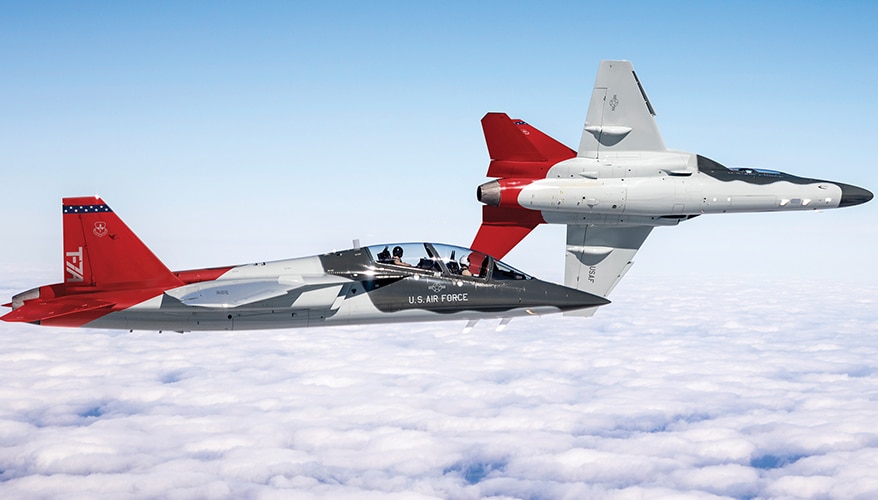Aerospace
Boeing Unveils First T-7A Red Hawk Advanced Trainer Jet to be Delivered to the U.S. Air Force

- The fully digitally designed aircraft is built and tested using advanced manufacturing, agile software development and digital engineering technology
The first T-7A Red Hawk advanced trainer jet to be delivered to the United States Air Force has been presented by Boeing [NYSE: BA]. The plane, which is one of 351 planned by the US Air Force, was unveiled ahead of its formal delivery.
The totally digitally designed aircraft was manufactured and tested utilising modern manufacturing, agile software development, and digital engineering technology, cutting the time between design and first flight in half. The aircraft also has open architecture software, which allows for future mission growth and flexibility.
Ted Colbert, president and CEO of Boeing Defense, Space & Security, said, “We’re excited and proud to deliver this digitally enhanced, next-generation trainer to the United States Air Force.” “This aircraft exemplifies how Boeing, its suppliers, and partners are driving the industry.”
In homage of the Tuskegee Airmen of World War II, the T-7A Red Hawk had a red-tailed livery. The first African American aviation unit in the US military was formed by these airmen.
“The Tuskegee Airmen are one of our Air Force’s most recognised organisations, and the T-7A celebrates the bravery and skill of these trailblazers,” said Air Force Chief of Staff Gen. Charles Q. Brown, Jr. “The T-7A Red Hawks, like the Airmen after whom they were called and painted, smash down the barriers of flight.” These digitally-engineered planes will be able to teach a wide range of future fighter and bomber pilots, as well as give an upgraded training system and capabilities.
Before being transferred to the US Air Force, the aircraft will be tested on the ground and in the air near St. Louis. The T-7A programme is based at Boeing’s St. Louis factory, with Saab’s Linkoping, Sweden facility building the aft component of the trainer. Saab will begin producing that part at its new manufacturing site in West Lafayette, Indiana, in the near future.
Boeing 747 jet clocked up just 42 hours in the sky is scrapped
Boeing, as a worldwide aerospace leader, designs, manufactures, and services commercial aeroplanes, defence goods, and space systems for clients in over 150 countries. As a leading exporter in the United States, the corporation taps into the skills of a worldwide supply chain to enhance economic opportunity, sustainability, and community impact. Boeing’s diverse workforce is dedicated to innovating for the future, leading with sustainability, and maintaining a positive work environment.
United Airlines orders 50 Airbus A321XLRs for transatlantic route expansion

Aerospace
Boeing Transfers Rocket Stage to NASA, Paving Way for Human Moon Mission

Boeing has achieved a significant milestone by providing NASA with the second core stage of the Space Launch System (SLS) rocket.
This crucial component, crafted at NASA’s Michoud Assembly Facility (MAF), is set to propel the Artemis II crew into lunar orbit, marking humanity’s return to deep space after a 50-year hiatus.
The monumental Boeing-built rocket stage, the largest element of the Artemis II mission, will embark on a journey aboard the Pegasus barge, traveling 900 miles to NASA’s Kennedy Space Center.
Comparison of two legendary aircraft B777x vs B747 aircraft:Click here
Upon arrival, it will be meticulously integrated with other essential Artemis II components, including the upper stage, solid rocket boosters, and NASA’s Orion spacecraft within the iconic Vehicle Assembly Building. This intricate integration process is a vital step toward the eagerly anticipated Artemis II launch, slated for 2025.
“Boeing-built products helped land humankind on the moon in 1969, and we’re proud to continue that legacy through the Artemis generation,” remarked Dave Dutcher, vice president and program manager for Boeing’s SLS program. “Together, with NASA and our industry partners and suppliers, we are building the world’s most capable rocket and paving the way to deep space through America’s rocket factory in New Orleans.”
NASA, Lockheed Martin Reveal X-59 Quiet Supersonic Aircraft:Click here
The delivery of Core Stage 2 marks a significant achievement in the evolution of the SLS rocket. Towering over 200 feet and powered by four RS-25 engines, this core stage, coupled with two solid-fueled booster rockets, will generate a staggering 8.8 million pounds of thrust. This immense power is crucial to launching Artemis II and future missions into the vast expanse of space.
The SLS rocket stands unparalleled in its capability to transport both crew and substantial cargo to the moon and beyond in a single launch. Its extraordinary capacity will facilitate the delivery of human-rated spacecraft, habitats, and scientific missions to destinations including the moon and Mars, ushering in a new era of space exploration.
-

 Travel1 week ago
Travel1 week agoAir India to Expand US Operations with Three New Routes After a Decade
-

 Travel2 weeks ago
Travel2 weeks agoWhy We Should Avoid These Stamps in a Passport
-

 Airlines1 month ago
Airlines1 month agoInvestigations Reveal Fake Chinese Titanium in Boeing and Airbus Jets
-

 Tech4 weeks ago
Tech4 weeks agoChina’s CATL Plans 1,800-Mile Electric Plane Launch by 2027
-

 Airport3 days ago
Airport3 days agoTop 10 Largest Airports in the World by Size
-

 Aerospace4 weeks ago
Aerospace4 weeks agoChina’s Fighter Jets Turn Wings into Autonomous Drones
-

 Airlines4 days ago
Airlines4 days agoAir India Rolls Out A350s for Delhi-New York JFK and Newark Routes
-

 Defence3 weeks ago
Defence3 weeks agoBoeing Enhances Chinook with New Engines and Block II Upgrades at $96 Million







